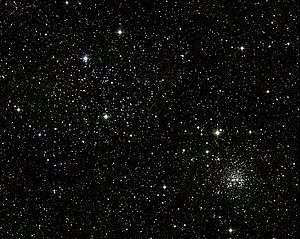Messier 35
Messier 35 or M35, also known as NGC 2168, is an open cluster of stars in the northern constellation of Gemini. It was discovered by Philippe Loys de Chéseaux around 1745 and independently discovered by John Bevis before 1750.[2] The cluster is scattered over an area of the sky almost the size of the full moon and is located 3,870 light-years (1,186 parsecs) from Earth.[1] The compact open cluster NGC 2158 lies directly southwest of M35.
| Messier 35 | |
|---|---|
 | |
| Observation data (J2000 epoch) | |
| Constellation | Gemini |
| Right ascension | 06h 08m 54.0s[1] |
| Declination | +24° 20′ 00″[1] |
| Distance | 3,870 ly (1,186 pc)[1] |
| Apparent magnitude (V) | 5.1[2] |
| Apparent dimensions (V) | 28[2] arcmins |
| Physical characteristics | |
| Mass | 1,600[3] M☉ |
| Radius | 11 ly[4] |
| Estimated age | 175 Myr[3] |
| Other designations | M35, NGC 2168,[5] Cr 82, C 0605+243 |
Leonard & Merritt (1989) computed the mass of M35 using a statistical technique based on proper motion velocities of its stars. The mass within the central 3.75 parsecs was found to be between 1600 and 3200 solar masses (95 percent confidence), consistent with the mass of a realistic stellar population within the same radius.[6] Bouy et al. (2015) found a mass of around 1,600 M☉ within the central 27.5′ × 27.5′. There are 305 candidate members with a probability of 95% or higher, and up to 4,349 with a 50% membership probability. The cluster metallicity is given by [Fe/H] = −0.21±0.10.[3]
Of 418 probable cluster members, Leiner et al. (2015) found 64 that have variable radial velocities and thus are binary star systems.[7] Four probable cluster members are chemically peculiar stars, while HD 41995, which lies within the cluster area, shows emission lines.[8] Hu et al. (2005) found 13 variable stars in the cluster field, although at least three are suspect as cluster members.[9]
References
- Wu, Zhen-Yu; et al. (November 2009). "The orbits of open clusters in the Galaxy". Monthly Notices of the Royal Astronomical Society. 399 (4): 2146–2164. arXiv:0909.3737. Bibcode:2009MNRAS.399.2146W. doi:10.1111/j.1365-2966.2009.15416.x.
- Thompson, Robert; Thompson, Barbara (2007). Illustrated Guide to Astronomical Wonders: From Novice to Master Observer. DIY science. O'Reilly Media, Inc. p. 252. ISBN 978-0596526856.
- Bouy, H.; et al. (March 2015). "Messier 35 (NGC 2168) DANCe. I. Membership, proper motions, and multiwavelength photometry". Astronomy & Astrophysics. 575: 6. arXiv:1501.04416. Bibcode:2015A&A...575A.120B. doi:10.1051/0004-6361/201425505. A120.
- Stoyan, Ronald; et al. (2008). Atlas of the Messier Objects: Highlights of the Deep Sky. Cambridge University Press. p. 160. ISBN 9780521895545.
- "M 35". SIMBAD. Centre de données astronomiques de Strasbourg. Retrieved 16 November 2018.
- Leonard, P. J. T.; Merritt, D. (1989). "The mass of the open star cluster M35 as derived from proper motions". Astrophysical Journal. 339 (1): 195–208. Bibcode:1989ApJ...339..195L. doi:10.1086/167287.
- Leiner, E. M.; Mathieu, R. D.; Gosnell, N. M.; Geller, A. M. (July 2015). "WIYN Open Cluster Study. LXVI. Spectroscopic Binary Orbits in the Young Open Cluster M35 (NGC 2168)". The Astronomical Journal. 150 (1): 18. Bibcode:2015AJ....150...10L. doi:10.1088/0004-6256/150/1/10. 10.
- Paunzen, E.; et al. (April 2014), "Photoelectric search for peculiar stars in open clusters. XV. Feinstein 1, NGC 2168, NGC 2323, NGC 2437, NGC 2547, NGC 4103, NGC 6025, NGC 6633, Stock 2, and Trumpler 2", Astronomy & Astrophysics, 564: 8, arXiv:1403.3538, Bibcode:2014A&A...564A..42P, doi:10.1051/0004-6361/201423521, A42
- Hu, Juei-Hwa; et al. (August 2005). "Discovery of 13 New Variable Stars in the Field of the Open Cluster NGC 2168 (M35)". Chinese Journal of Astronomy and Astrophysics. 5 (4): 356–362. Bibcode:2005ChJAA...5..356H. doi:10.1088/1009-9271/5/4/003.
External links
| Wikimedia Commons has media related to Messier 35. |
- M35 – Nightskyinfo.com
- Merrifield, Michael; Rothery, Roy. "M35 – Open Cluster". Deep Sky Videos. Brady Haran.
- NASA Astronomy Picture of the Day: Mars and the Star Clusters (19 April 2006) - featured M35
- Messier 35 on WikiSky: DSS2, SDSS, GALEX, IRAS, Hydrogen α, X-Ray, Astrophoto, Sky Map, Articles and images
